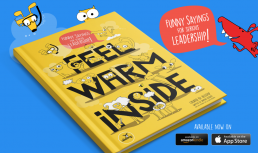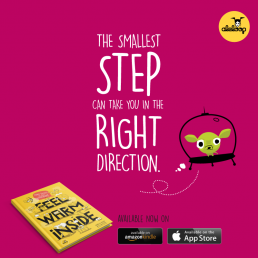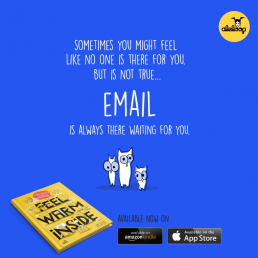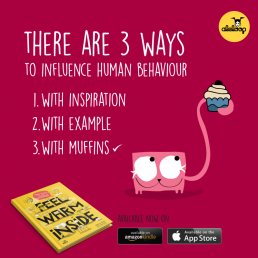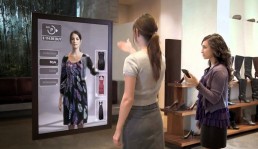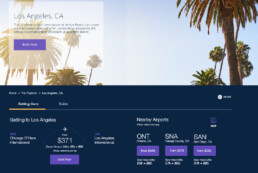New Book on Amazon
New Book on Amazon!! Feel Warm Inside: Funny sayings for leaders of all ages.
Feel Warm Inside: Funny Sayings for Serious Leadership is the perfect antidote to traditional books about leaders and leadership! This book is a funny, honest and imaginative view of life and leadership, that will help you on your very serious journey of becoming the leader you were meant to be. Doesn’t matter if you are an experienced leader or if it’s just you and your cat…this book is for you. After all, the true measure of a great leader is not their title, or the location of your office, but their ability to adapt. Good attitude, humor, and the right mindset can help you navigate into the weird, unpredictable and ever-changing world of adulthood…and the workplace.
Feel Warm Inside is a collection of funny, motivational sayings that celebrate the irony of adulthood while at the same time delivering a thought-provoking and often hilarious dose of self-awareness and inspiration for leaders of all ages. You don’t have to be perfect, you just have to be you. You are far better that your Instagram pic.
La realidad aumentada (AR) y la realidad virtual (VR) han dejado de ser una “novedad” para transformarse en una realidad, impulsando no solo un modelo de usabilidad del futuro, sino también un potencial cambio de paradigmas en el ecosistema de negocios.Esta tecnología virtual no está solamente limitada a los juegos o al entretenimiento. E-commerce, transporte, medicina y moda se verán revolucionadas en el futuro cercano que, más que una moda tecnológica, promete ser una nueva forma de experimentar el mundo. Si bien estamos acostumbrados a las experiencias digitales, el diseño y desarrollo de experiencias e interfaces para VR y AR siguen siendo algo nuevo y muchas veces implican un gran desafío, tanto desde lo tecnológico hasta su usabilidad. Miremos algunos conceptos claves, desafíos técnicos y modelos de negocio posibles de esta nueva manera de interpretar la realidad.
Realidad Premium
Las interfaces de usuario de AR han mejorado mucho, más allá del aspecto tecnológico, presentando la información de forma 'más natural', en tiempo real y principalmente, donde se encuentra el usuario. Pero en definitiva, la AR no deja de ser una “opinión” o punto de vista respecto al mundo real. Para las empresas puede representar un objetivo que, incorpora información adicional para aumentar esta opinión. Todas las formas de ver el mundo son opiniones: buenas, malas, útiles, etc. pero al fin son solo eso, opiniones, expresadas a través de datos (texto, imagen, vídeo, etc.). Por ejemplo, una imagen satelital de tu barrio (realidad) cubierta con nombres de calles, flechas u otra información es una 'aumentación'. En sentido amplio, el mundo es una plataforma y lo que vemos representado visualmente y como interactuamos, es la UX de nuestra vida.
Herramientas de diseño AR/VR
Antes de pensar en diseñar una interface de AR/VR, deberíamos preguntarnos cómo funciona. Las herramientas para diseñar y desarrollar prototipos de interfaces de realidad virtual y aumentada son diferentes de las utilizadas en el diseño y desarrollo de aplicaciones digitales tradicionales, por ejemplo, InVision, Adobe o Prototype, etc. Incluso no solo el software sino también tenemos que contar con una maquina potente como para procesar toda la información y en algunos casos gafas especiales o dispositivos para testear los resultados. Incluso para los diseñadores es difícil encontrar inspiración y más aún encontrar información sobre buenas prácticas y metodologías de desarrollo de AR/VR, ya este campo esta “virtualmente” inexplorado. Existen miles de fuentes y libros acerca de prácticas y metodologías de desarrollo de web y mobile, pero para diseños virtuales muy poco se sabe, y hasta podemos contar con los dedos de una sola mano casos de éxito comercial.
¿Como funciona el proceso? Un sensor (cámara) observa parte de la realidad. Esta imagen se combina con metadatos/catalizadores (etiquetas de geolocalización, gráficos o códigos específicos a nuestra app) y desencadena un evento correspondiente. Por ejemplo: Vamos a un museo o un lugar histórico, y una etiqueta de geolocalización en nuestra app o dispositivo nos muestra un gráfico sobre una pintura o un monumento. Esta 'match' de metadatos sobre el objeto o lugar recupera la información pertinente al respecto, combinando elementos sobre la imagen original, desencadenando un evento que muestra información pertinente.Para realizar este proceso los dispositivos tienen que contar con sensores de alta calidad, conexión en tiempo real y una UX clara y precisa. Comprender “la escena” es clave, para poder activar el ‘matching’ de información y generar la imagen “aumentada”. Estos elementos relevantes se obtienen a través de la interacción con el usuario, captando su atención a medida que observemos su contexto inmediato, intención y comportamiento, por ejemplo, seguimiento de mirada, tacto, gestos y reconocimiento de voz, determinando qué componentes del mundo real aumentar
Metodologías para diseñar interfaces AR/VR
Si bien se han producido algunos desarrollos exitosos, continuamos en una etapa de investigación y desarrollo. Empresas como Apple, Amazon y Google actualmente impulsan esta tecnología. Pero la realidad es que estamos ‘jugando’ o experimentando y los resultados de nuestras interfaces todavía no sean lo suficientemente intuitivos y de gran usabilidad como con nuestras appss web o mobile. Aunque compartimos muchos parámetros y disciplinas con nuestra contraparte mobile, crear aplicaciones de AR/VR ni se compara con ella. Una experiencia o interface de AR/VR mal o pobremente diseñada podría poner en peligro la integridad física de sus usuarios. Sumergirse en una experiencia de realidad aumentada o virtual es otra historia. El año pasado estuve en la muestra de Björk y hubo gente que salía con dolor de cabeza, mareada y desorientada. He visto gente caerse de sillas en eventos con gafas de realidad aumentada.
Asimismo, imágenes y arte que parecen espectaculares y vibrantes en un website, en AR/VR no funcionan. Los desarrolladores deben ser precavidos en este sentido. Conducir un testeo de usabilidad de estas tecnologías es todo un tema, además recordemos que estamos trabajando en 3 dimensiones. Técnicas que son eficaces en desarrollo en 2 dimensiones son a menudo ineficaces para experiencias AR/VR.
En búsqueda de una experiencia inmersiva, creamos con mi equipo salas de wireframing en 3D 'real', hecha conelementos cortados en papel y cartón colgando de hilos, con anteojos hechos por nosotros mismos, simulando una interfaz, y testeandolos en una sala a oscuras.
Nuestros usuarios voluntarios (amigos y parientes) 'navegaban’ nuestro mundo virtual como si fuera una interface 'tamaño natural'. Sin casco virtual, ya que los costos eran prohibitivos, pero tuvimos un acercamiento real que nos permitió entender los desafíos del usuario al desarrollar la experiencia. Creo que a medida que haya mayor crecimiento comercial en el área, mayores serán las herramientas que aparezcan, pero por el momento, todo es bastante casero.
Tipos de plataformas
1-Teléfonos móviles: ya hay mucho dicho respecto a telefonos móviles. Poseen cámaras de alta sensibilidad, capacidades de geolocalización, reconocimiento facial y numerosos sensores que posibilidad una experiencia contenida y focalizada.
2-Vehículos: el parabrisas del vehículo proporciona una interfaz ideal para la representación de información localizada. Muchos de estos vehículos “inteligentes” tienen ilimitada energía (eléctrica/solar) y puede soportar gran cantidad de datos y comunicaciones. Fabricantes europeos de autopartes ya están desarrollando proyecciones translúcidas de AR, que permiten a los pilotos o controladores ver información sin tener que retirar la vista del camino.

3-Dispositivos “usables” comúnmente llamados wearable techcomo gafas holodecks (como los fallidos Occulus o Google Glass) y sensores “usables”para piel, vestimenta o zapatos, que aportan datos ambientales y biométricos para ser procesados por las aplicaciones. Muchos de ellos todavía en etapa de investigación y con limites en potencia y transmisión de datos, son caros, y les falta el condimento de ‘masividad’ o necesidad’como tienen los celulares hoy en día.

Parámetros básicos para un prototipo de AR
Estas categorías nos ayudaran para visualizar la experiencia de manera holística aplicando ciertos parámetros o elementos que nos ayuden a acercarnos al objetivo de nuestra experiencia:
Desencadenante o “trigger”: Es el evento o la observación sobre el cual el “aumento” se produce. Proporcionando información acerca de los lugares de interés cercanos, habilitando a los usuarios a buscar restaurantes, hoteles y tiendas, u obtener más información acerca de ellos como los anteojos Vuzix Blade o Apple Smart Glasses.
Interactividad: es cómo los usuarios interactúan con la información 'aumentada' a través del gesto, mirada, voz y posicionamiento, incluso a través de la voz o sonidos.Un ejemplo de alta interactividad pueden ser anuncios que se abren automáticamente para revelando descuentos al acercarme. Esto lo vimos en la película Minority Report.
Naturalidad: Eventos desencadenados por objetos de realidad natural, reconocibles o integradas al medio ambiente
y/o con objetos físicos, tal como lo está utilizando Amazon.
Preguntas a la hora de diseñar una UX de realidad aumentada
Paradójicamente la realidad aumentada “aumenta” los problemas y desafíos, amplificando los mismos retos de usabilidad de las interfaces tradicionales, ya sea sobrecargar los usuarios de información o de como determinar una acción especifica. Para abordar problemas de usabilidad, los diseñadores deben centrarse en ciertos puntos clave:
1-¿Puede el usuario notar la diferencia entre la realidad y ’aumentación’? La confusión podría llevar a errores del usuario si una aplicación transmite una impresión errónea del mundo.
2-¿El 'aumento' (y no de precios en la canasta familiar) está alineado con la realidad? La alineación en tiempo real es muy importante ya que la realidad puede cambiar rápidamente. Por ejemplo, una app de navegación de AR, la señal de tráfico cambia su estado constantemente, pudiendo ocasionar un accidente si la info aumentada bloquea o no esta actualizada.
3-¿Cómo puede un usuario transicionar entre AR apps y aplicaciones tradicionales?Siempre hay que tener en mente al usuario, ayudándolo a resolver tareas, o en su búsqueda de contenido e información. Es una experiencia global y la AR es un elemento genial para la transición. Por ejemplo, dentro de un ambiente tradicional dedicar un lugar condicionado especialmente para AR.
4-¿Cómo debería organizarse la información 'aumentada'? Por ejemplo, si un producto viene en diferentes variedades, colores o precios, sería de gran ayuda una taxonomía coherente para agrupar productos relacionados/ alineados con la intención del usuario. Una aplicación de AR que presenta toda la información a la vez podría confundir al usuario.

Desafíos sociales
AR / VR es muy diferente a otras tecnologías informáticas tanto por lo que realiza y por sus características físicas complejas. Como toda nueva tecnología, pueden pasar años (o meses) antes de ser masivamente adoptadas. Entretenimiento, turismo y automóviles han comenzado a incorporar AR/VR a su terminología diaria de uso. La tecnología AR /VR es válida y útil dependiendo del contexto del usuario, y a las regulaciones que de privacidad que comparten con otras aplicaciones tecnológicas hermanas, la privacidad de los usuarios, de su ambiente y su seguridad son riesgos potenciales a tener en muy en cuenta. Hoy en día, los usuarios son muy escépticos -con razon- acerca de dónde y cómo las empresas obtienen nuestros datos personales y como mis hábitos de consumo ya están cualificados en algoritmos con nombre y apellido.
El futuro del negocio multidimensional
No hace falta ser un visionario futurista para entender que AR/VR se convertirá en un negocio durante la próxima década?- Si el E-Commerce y las plataformas VOD revolucionaron el mercado de como los usuarios consumen contenidos, servicios y demás aspectos de la vida cotidiana, imaginemos el próximo paso si incorporamos experiencia virtuales aumentadas. ¿Salir al supermercado sin moverte de tu living? Una locura no muy loca. ¿Comprarte ropa desde tu propio cuarto sin ir a una tienda? son aspectos que las grandes marcas como Amazon ya están implementando.
Por ejemplo, en lugar de mostrar anuncios por palabras clave, como en la web, la publicidad en AR podría mostrarse por metadata de geolocalizacion o patrones. Esta transición ya dejo de ser experimental para muchas empresas que ya están desarrollando un nuevo ecosistema de negocios.
Netflix, hace 14 años te enviaba 3 DVD de películas por correo, y recuerdo que era una increíble novedad, que termino desbancando a las tiendas de ‘Blockbuster’, forzando a los gigantes del cable a replantear su estrategia comercial. Esto paso prácticamente ayer.
Para muchos realidad aumentada y realidad AR son solo pruebas de concepto, pero tienen éxito y mucho potencial. Con el tiempo, nuevas herramientas y metodologías de desarrollo surgirán, convirtiendo a la realidad aumentada y virtual en una experiencia habitual para el usuario y como creadores del futuro, tenemos que estar preparados.
Optimizing your media strategy can generate a significant budget release, either for growth reinvestment or return to bottom line.
As your company’s content strategy becomes more sophisticated, your marketing budgets become bigger and more complex, demanding top-notch planning efficiency. Global marketing spend exceeds $1 trillion, around 1 to 2 percent of global GDP and keeps growing faster.
beforehand, this requires stepping back to evaluate priorities and best practices to achieve that, understanding the strengths and weaknesses of each type of planning. When blended together, you end up with a highly effective strategy that moves your business forward much more quickly than focusing on a single tactic alone, allowing the investment to be effective. The goal is to be more efficient and by experience, it can be achieved. The key is to progressively incorporate certain practices into your daily planning.
TEST YOUR BUDGET “USABILITY”: FROM CARD SORTING TO JOURNEY MAPPING…ALL YOU CAN EAT UX BUFFET
1-Create a visual spent landscape I used this technique from my storyboarding days and now is a must-use tool in UX design. It’s like pitching the budget to yourself! Take a wall and use as many post-its until you see the full budget ecosystem. It really works.
2-Ensure alignment across units: create an objective analysis of economic, strategic, and marketing-oriented criteria for each brand. Better marketing return of investment (MROI) starts with better and clear objectives.
3-Align your targets: clarify and align mismatched marketing and sales targets, it will bring light into your budget allocation efforts.
4-Consolidate your brand spending: sort your spent in relation to your growth goals and forecast: grow aggressively, grow, sustain, etc.
5-Find relevant drivers of value: made your mission to constantly find new ways to engage and guide customers. New experiences, new channels, research, communications or content, your brand should bring innovation and expertise.
6-Identify the most effective media and channels: spending in the right places will reach more priority customers, whether is online or in-store -or your partner venue- it will most likely to be a hit. Find out where consumers make their decisions. Data-driven media spent is an extremely efficient way to advertise.
7-Country-based budget: Consider the particulars of each country’s multicultural context and shift spending from lower- to higher-priority markets.
8-Generate internal communications: demonstrate to the rest of the organization how the new allocations would benefit the company overall. Every successful planning needs everyone in the company to be involved and supportive.
9-Identify your consumer's journey: use digital analytics, social media management, in-store initiatives, and post-purchase online service. Understanding the consumer path from research and consideration to purchase and brand loyalty.
10-Focus on your consumer's experience: deliver consistent high-quality content for use across touch-points both online and in-store. This also applies to your partners’ experience, think of them as your ambassadors and evangelist. Create a workshop or a learning event. An online channel exclusively for your partners could be a hit -and a relatively inexpensive- way to get where your audience is.
CONCLUSION:
You can mix and match these UX practices like colors on a palette to create the right vision of your media budget into a successful work of art.
Let me know what you think. Thank you!
The new audience identity
Understanding your audience in this ever-complex marketplace requires a unique ability to combine massive amounts of measurement information with the right perspective.
While entertainment industry is changing the way they do business, technology is doing its part. Analytics tools had proven to be successful, making connections between pieces of research, identifying facts and behaviors. But if we want to understand how our audiences interact with our content, we might need to change how questions are made.
The New Audience Format
Spoiler alert. There's is no audience format anymore. Audiences have grown to become agnostic, nomadic, multi-tasking, experiential and very direct. There are no two viewers alike. In the same demographic, they might not share the same interests. Most of the time they are ‘uninspired’ by expensive Networks marketing extravaganzas. Options multiply with every tweet, facebook like or selfie ever taken. If you’re not reaching, engaging, and monetizing your audience, you’re likely losing them to someone else.
Changing the concept of engagement
When it comes to understanding, all the information you can get is important. But you have to be smart and sensitive in order to relate effectively. Read the signs, get feedback, and adjust your approach as necessary. Think of an audience in terms of a “first date”. Analytics can give you a way to read your audience “body language”. You’ll get tons of real time feedback. From measurement tools, analytics apps and marketing research, you get to embed with your product, and how much you can play out. It’s important to have all the details, but the key is to understand how to read the information. You got to be responsive.
A subtle smile, eye contact, mirroring, head-tilt, all require a bit of interpersonal sensitivity. Look at the trends in the social media; keep an eye on relevant comments. The right timing or even the weather can give you a metric that algorithms might have missed. Take a moment, observe, and the pointers will become visible. You’ll actually see your audience ‘body language’ the way Neo sees The Matrix.
A relevant example is the movie Jurassic World. The audience ‘body language’ was pretty clear: On that weekend, the re-post rate for Jurassic videos on YouTube was 45 to 1 (the average is 9 to 1). The trailer on the official Universal channel got 66.6m views (multi-channel networks money well invested) Twitter almost broke: #JurassicWorld peaked at 63K. The “conversation” for the film was very high and very positive on social media that weekend. Thousands and millions share trailers with their community, on multiple social channels. And that’s intent of purchase...like a kiss. Plus, no big sports events or soccer matches on TV that weekend. Add shirtless Chris Pratt and school calendars and TV were packed with dino-theme curricula. Finally, people just love seeing Pterosaurs munching on tourists! Go family-friendly entertainment! Jurassic World broke the box office, scoring the biggest opening weekend in history with a sweet $511.8 million in tickets sales worldwide, outdoing even Harry Potter. Universal Studios had a nice date!
Conclusion. Audiences consume and interact with information in unexpected ways, so you have to be tuned in real-time. Consider what’s going on in the analytics and reports, and outs of them. Data is generated and delivered by the same audience you are trying to connect, from video channels, chat, social media and tweets. Paying attention to the ‘vibe’ or body language cues can go a long way. Use them to your advantage. Analytics can be tricky, but they are just the tip of the data iceberg. Keep your cool, be yourself and be responsive. Pick your actions accordingly and maybe it could be the start of an unforgettable relationship.
How to create a hit with a low budget and a clever strategy
Deadpool has always been a fairly popular Marvel character among hardcore fans, but relatively unknown to the rest of the world…until today. He’s a kind of quirkish, snarky anti-hero with a natural ability to break the fourth wall to communicate with his readers/audience, usually to mock the super hero cliché. Against all odds, Deadpool made it to the big screen, and compared to others in the same genre, with a tiny $58 million budget.

From the buzz and temperature of social conversations from these past weeks, looks like Deadpool is going to break some barriers over the weekend and the people at Fox and TSG(financiers of Fox live action movies) are going to be celebrating next week. Why? Because they had created a hit out of nowhere. And off course, the movie is pretty entertaining, despite the R rated label. Looks like someone at Fox marketing is planning and executing the right way some key strategic moves:
1.Release date
Deadpool probably will beat their weekend competition in this long president weekend.Zoolander 2 have drawn on nostalgia viewership and also a good campaign to cash on tickets to save the day. And How to be Single, the Dakota Johnson romantic flic, well…is just that. Deadpool release date feels like it was “under the radar” in the distribution timeline because there are literally not many movies for grown-up audiences to go. Big Oscars contenders have their on fight last week, Fifth Wave is a bore, and Zootopia is due next week, so Deadpool has a green wave to rise above the numbers. Plus, is Valentine weekend, with basically no “The Notebook” movies in sight. So this quirky potty-mouthed anti-hero is the royal ambassador of anti-valentine audiences.

2.Marketing Campaign
We all know that a box office hit need good PR and Marketing strategy, but honestly, most of the studios FAIL on these matter, and don’t tell me because of the budget. Advertising is not all about showing the movie trailer or character posters here and there. Its about building a brand. The marketing around the upcoming film has been nothing short of phenomenal, deserving of a glowing five out of five chimichangas. The trailers and promos for the film have all been tongue in cheek and absolutely hilarious, playing off of different trends and tropes to create unique communications. Seriously, if the ads are this good, just imagine what awaits fans in the theaters (eat your heart out Star Wars). Even they did a Valentine style campaign that is just brilliant

3.Social Media Strategy
We’re living in a postmodern, meme-culture, hero over saturated age. Audiences are CRAVING for some originality. No more remakes, no more sequels, no more cinematic universes with happy meal toys and epic superhero faces in a box of cornflakes. Deadpool itself is a bit of a snarky commentary on the over exposure of the genre, even an R-rated very violent superhero movie, but guess what, its unique. The audience age is that perfect 18-34 years old, which are highly social users. So, its no surprise that online conversations about Deadpool are hot on Reddit, Facebook, Twitter, YouTube, Instagram, you name it, where fans can engage and engage others. The movie has been promoted virtually only through social media. In fact, the movie was only green-lit after test footage was “leaked” on social media. Fox released a red-band trailer unsuitable for TV, and the movie landed an R-rating. So marketing made up for the lack of television ads with their creative social media campaign. During the holidays, they spoofed the 12 Days of Christmas, with #12DaysofDeadpool, which spotlighted special content released each day. The content included downloadable videos, pics and emoji’s. And also took over Valentines with fake gushy romantic Ads all over the internet and street billboard.

The big man @ ComScore, Paul Dergarabedian, said this today about Deadpool: “This may be the first movie of 2016 that kind of elevates everything, and gets that box office momentum charged.” Sweet remark. Again, its all about building a brand.
The movie is also off to an impressive start overseas, with a tracking of more than $90 million for the weekend. Deapool is on fire at the box office today: it began playing at 7 p.m. in 2,975 locations; on Friday, it expanded into a total of 3,558 runs, including Imax locations. The Imax portion of Thursday night’s haul was $2.3 million, the sixth biggest preview ever for the large-format circuit.
Once ranked nr. 182nd out of 200 in the popularity list of Marvel properties, Deadpool is on its way to become a success. The movie probably step over the heels of Guardians of the Galaxy ($94.3 million) and Captain America: The Winter Soldier($95 million) and likely score the biggest R-rated opening of all time. Tip of the hat to the marketing team @ Fox.
Deadpool, starring the sexy-mouthy Ryan Reynolds, beautiful Morena Baccarin, Ed Skrein, T.J. Miller and Gina Cara, all directed by Tim Miller.
Creating value through data
Creating a cost-efficient experience
Development, printing, and shipping more than a million Premiere Status Kits around the world were costly in resources and production. We needed to create not just a great experience that communicates that delivers the information, but also the value and experience that each tier deserves and also create opportunities for business.
A solution that brings value to the business and the users.

Understanding what’s more valuable for our customer
Change the color to match your brand or vision, add your logo, choose the perfect layout, modify menu settings, add animations, add shape dividers, increase engagement with call to action and more.
We started our journey-mapping initiative looking for existing, relevant data both qualitative (from past focus groups, customer-support logs, social media feedback) and quantitative (analytics, customer-satisfaction scores, etc.) to get a detailed understanding of our customer’s general attitudes and levels of satisfaction for specific interactions, and uncover missed opportunities and implementing new ideas.
